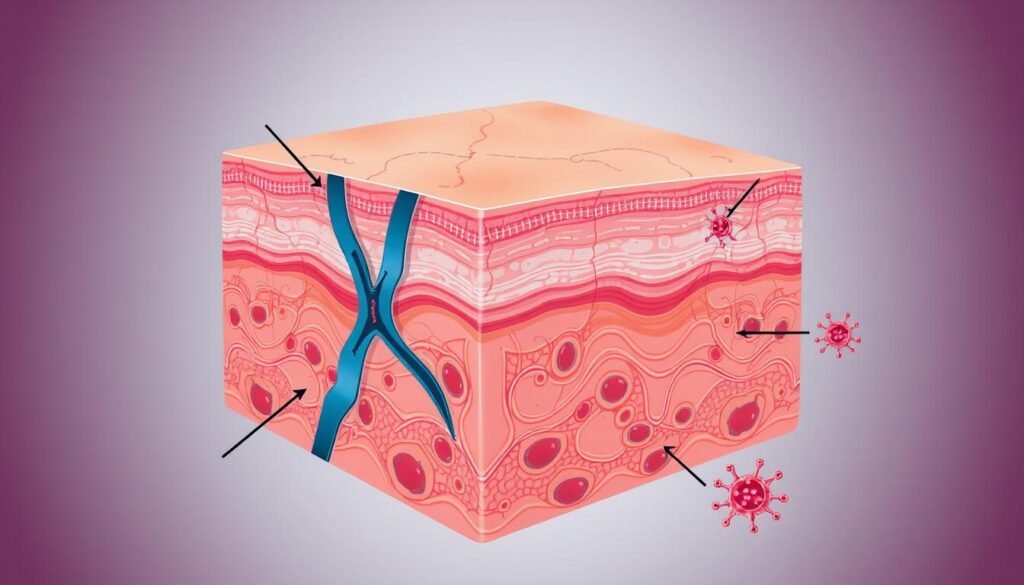Did you know over 31 million Americans are living with eczema? Atopic dermatitis is the most common form. It affects people of all ages, but especially young kids. Most children get it by age five. This skin issue causes a lot of discomforts and has many triggers. Knowing what causes atopic dermatitis helps manage symptoms and avoid bad flare-ups.
Let’s explore how genetics and the environment play a role in atopic dermatitis. Around 70% of people with this condition have family with eczema or allergies. Finding out specific triggers helps in taking care of it better. It’s important to know what makes symptoms worse. For more details, visit this page on atopic dermatitis here.
Key Takeaways
- Atopic dermatitis affects over 9.6 million children and 16.5 million adults in the U.S.
- The condition is often inherited, with significant genetic links.
- Environmental factors like air pollution may increase risk, especially in urban areas.
- Identifying and avoiding triggers is essential for managing the chronic condition.
- Stress can contribute to eczema flare-ups, emphasizing the need for emotional well-being.
- Routine skin care is crucial in alleviating symptoms and preventing complications.
Understanding Atopic Dermatitis
Atopic dermatitis is a long-lasting skin issue that affects many, especially kids. It shows up as an inflammatory rash that’s dry, itchy, and often red. Most of the time, it starts in babies, with 60% getting diagnosed before turning one. While some outgrow it by twelve, many continue to deal with it into adulthood.
Today, 10% to 30% of children and 2% to 10% of adults in developed countries have it. This rise makes it essential to learn more about atopic dermatitis. It can show up on different body parts, like behind the knees and inside the elbows. This causes a lot of discomfort and distress.
Those with atopic dermatitis often deal with a cycle of itching and scratching. This can worsen the rash and cause infections. If you have a family history of asthma or hay fever, you’re more likely to get this skin disorder. Although it’s not contagious, it can greatly affect your daily life and how you feel emotionally.
Treating atopic dermatitis needs a careful plan. This includes keeping the skin moisturized and staying away from triggers. With new treatments like biologics and creams, there’s hope for those fighting this skin issue.
What Are the Symptoms of Atopic Dermatitis?
Atopic dermatitis, or eczema, affects people of all ages. It shows many symptoms that make life harder. One key sign is itchy inflamed skin. This causes lots of scratching and discomfort.
People often see dry scaly patches on their bodies. These patches mainly show up on elbows, knees, and on babies’ and toddlers’ faces. Eczema flare-ups happen too. They make symptoms worse, which is really tough to deal with.
Common Symptoms Experienced
Symptoms of atopic dermatitis include:
- Severe itching
- Dry, cracked skin
- Red or inflamed rashes
- Thickened, leathery patches of skin
- Blistering and oozing in severe cases
- Changes in skin color, like dark brown or gray patches on darker skin
Symptoms can start at any age but are more common in young kids. Some kids might see their skin get better as they grow. However, many people still deal with eczema as adults. This means they have to keep finding ways to manage it.
Variations in Symptoms Across Different Skin Tones
Skin tone can change how eczema symptoms look. Lighter skin might show more redness and rashes. But on darker skin, dry scaly patches might look like rough bumps. Understanding these differences is key. It helps people spot flare-ups early on. This early detection makes it easier to control symptoms. For more about this, check out atopic dermatitis and its complexity.
Atopic Dermatitis Causes
Atopic dermatitis is often called eczema. It comes from both genetics and the environment around us. Knowing why it happens is key to control and feel better.
The Role of Genetics in Atopic Dermatitis
Genetics matter a lot in atopic dermatitis. If your family has a history of eczema, allergies, or asthma, you might be more at risk. Certain genes, like the ones linked to filaggrin, affect how our skin defends itself. This can make our skin react badly to things that don’t bother others much.
This reaction can cause really bad symptoms.
Environmental Factors and Their Impact
What’s around us also triggers symptoms of atopic dermatitis. Scratchy clothes, some cleaners, and perfumes can make it worse. Dry skin, especially in cold, low-humidity winters, can cause flare-ups too.
Other triggers like dust mites, animal fur, pollen, and cigarette smoke can also add to the problem. It’s a mix of our genes and environment that shapes how we deal with this skin issue. That’s why finding ways to prevent and treat it is super important.
Common Triggers of Atopic Dermatitis
Knowing what causes atopic dermatitis flare-ups is key. Dry skin is a big trigger. It makes the skin more likely to react to irritants and allergens because it can’t hold moisture well.
Dry Skin and Its Effects
Dry skin can make atopic dermatitis worse. Without enough moisture, skin can crack and flake. This makes it easy for irritants to get in. Studies show dry skin is often linked to more frequent flare-ups. Keeping skin moisturized helps a lot. Creams and emollients are good because they keep moisture in and improve skin health.
Common Allergens and Irritants
Many things can cause eczema to flare up. The most common include:
- Soaps and detergents
- Dust mites
- Pollen and molds
- Fragrances in personal care products
- Wool and synthetic fabrics
- Certain foods, like milk and eggs, especially in kids
Avoiding allergens is important. Identifying and avoiding things that trigger flare-ups can help. Using products without fragrance and made for sensitive skin helps. So does wearing natural fibers and keeping your space clean to cut down on dust and mold.

| Trigger Type | Examples | Impact on Skin |
|---|---|---|
| Irritants | Soaps, detergents, fabrics | Increase dryness and irritation |
| Environmental Allergens | Pollen, dust mites | Worsen allergic reactions |
| Food Allergens | Milk, eggs | Might lead to skin flare-ups in children |
By avoiding allergens and keeping skin moist, life can get better for those with atopic dermatitis.
The Importance of Identifying Triggers
Knowing what sparks your eczema is key in handling it. Learning about the specific things that bother your skin helps you avoid them. This way, you can keep flare-ups to a minimum. Keeping an eye on what you’re exposed to lets you make smarter choices for your skin.
To figure out what’s triggering your eczema, keep a detailed diary. Write down how your skin reacts to different products, foods, and the environment. Tracking these things helps you see patterns and understand what affects your eczema. Sometimes triggers don’t show symptoms right away, so regular note-taking is important.
It’s important to get advice from healthcare experts. They can help find out what’s causing your flare-ups with tests like patch testing. This step can make your skin care much better. It allows for care that’s just right for you, helping you find long-term relief.
Stopping flare-ups before they start is key. Do this by staying away from things you know bother your skin, using moisturizer regularly, and keeping stress low. Often, just changing a few everyday habits can really improve your skin’s health and your happiness.
| Trigger Type | Examples | Management Strategies |
|---|---|---|
| Environmental | Cold, dry air, humidity | Avoid exposure during extreme weather; maintain indoor humidity levels |
| Allergens | Pollen, dust mites | Use air purifiers; practice regular cleaning |
| Irritants | Soaps, fragrances, certain fabrics | Select gentle, fragrance-free products; wear breathable fabrics |
| Food | Dairy, nuts, gluten | Consult a dietitian; perform elimination diets if necessary |
| Stress | Anxiety, lack of sleep | Practice relaxation techniques; maintain good sleep hygiene |
Understanding how to spot what triggers your eczema puts you in charge. This knowledge is a powerful tool in caring for your skin. It leads to actions that can make your skin healthier and improve how you feel every day.
How Stress Influences Atopic Dermatitis
Stress and atopic dermatitis have a complex relationship that affects skin health. High emotional and psychological stress can worsen eczema symptoms. Knowing how stress impacts skin can guide in choosing effective stress management techniques.
The Connection Between Stress and Skin Health
Studies show stress can break down the skin’s protective barrier. It lets irritants in and changes immune responses. This can lead to more allergic reactions and worse atopic dermatitis. Some people’s genes make them react more strongly to stress.
When stressed, our bodies release neuropeptides that can cause inflammation. They also activate skin mast cells, making eczema worse. The stress of living with this skin condition can make people feel embarrassed. This feeling can harm their mental health and lead to anxiety or depression.
To fight stress’s negative effects, try these:
- Regular physical activity: Do 150 minutes of moderate exercise a week for better mental health.
- Mindfulness and meditation: These can calm your mind and body, lowering stress.
- Cognitive-behavioral therapy: It helps change how you respond to stress, making you cope better.
These strategies not only improve your mental health but also your skin. Studies highlight the importance of managing stress to treat atopic dermatitis effectively.

Food Allergies and Atopic Dermatitis
It’s key to know how food allergies and atopic dermatitis affect each other. Studies show about 30 percent of kids with atopic dermatitis also have food allergies. This makes it important to watch out for certain foods. Eggs, dairy, peanuts, and shellfish are common triggers.
Common Foods That May Trigger Flare-Ups
Eczema symptoms can get worse because of food allergies. Let’s look at foods that often cause more problems in atopic dermatitis:
- Eggs
- Dairy products
- Peanuts
- Soy
- Wheat
- Shellfish
Understanding the Relationship with Other Allergies
The link between food allergies and other allergies, like hay fever, is complicated. Kids with atopic dermatitis might be more sensitive to different allergens. This means we need to watch their symptoms closely. Between 30% and 80% of patients with atopic dermatitis might react to food allergens. Getting the right diagnosis and treatment plan involves talking to healthcare experts. This might mean changing diets.
If we tackle food allergies, we can manage severe eczema better and make the skin healthier. For personalized care, checking out effective treatment options is a good move.
Skin Barrier Dysfunction and Atopic Dermatitis
The skin barrier is key to defending against environmental dangers. It’s very important for people with atopic dermatitis (AD). This dysfunction often starts the chronic inflammation seen in AD. Knowing how this happens can help find good treatments.
Role of Filaggrin in Skin Health
Filaggrin is a crucial protein for skin’s structure and moisture. It forms the skin barrier and keeps skin hydrated. Nearly half of the people with worse AD cases have issues with their filaggrin gene. When there’s not enough filaggrin, people lose more water through their skin. This leads to dryness and makes the skin open to irritants and germs. Filaggrin’s role is major, especially for those with AD.
How Skin Barrier Compromise Leads to Flare-Ups
A damaged skin barrier causes many changes. These changes include a drop in ceramide and cholesterol levels, weird pH levels, and more serine proteinase in the outer skin. These issues can start an immune response, causing inflammation and symptoms to get worse. Regularly using moisturizers that help the barrier can lower relapse rates in AD sufferers. This shows how key it is to keep the skin barrier strong to stop symptoms from getting bad.

Studies show that early action on skin barrier issues can make AD less severe and even change how it develops. Treating it well means using moisturizers, creams, and other therapies that focus on specific immune problems. Better understanding of AD types could lead to treatments that really fit the person. For more details, check out research on skin barrier dynamics related to AD.
| Skin Barrier Abnormalities | Consequences |
|---|---|
| Filaggrin deficiency | Increased TEWL and dry skin |
| Reduced ceramides | Epidermal barrier permeability issues |
| Altered pH | Higher susceptibility to infections |
| Elevated serine proteinase activity | Increased inflammation and irritation |
Management and Treatment Options
Dealing with atopic dermatitis means using different treatments and a careful skin care plan. The first step usually involves topical corticosteroids. They are key in lowering inflammation and easing eczema symptoms. Knowing how to use these medications daily can make a big difference for those with this skin condition.
Topical Corticosteroids
Doctors often prescribe topical corticosteroids for eczema outbreaks. These meds reduce redness, swelling, and itchiness. It’s important to follow a doctor’s advice and not use them too much to avoid side effects. They come in various strengths for different needs and places on the body. Doctors may also suggest calcineurin inhibitors for tougher cases.
Moisturizing and Skin Care Routines
A strict skin care routine is crucial for managing atopic dermatitis. Using moisturizers regularly helps keep the skin hydrated. This reduces dryness and fewer flare-ups. One should apply emollients liberally twice a day, especially after bathing, to seal in moisture. Choosing products without fragrances and harsh chemicals is better for your skin. Applying anti-itch creams can offer extra relief during tough times.
| Type of Treatment | Usage | Best For |
|---|---|---|
| Topical Corticosteroids | Applied directly to affected areas | Redness, swelling, itching |
| Calcineurin Inhibitors | Applied to the skin to reduce inflammation | Moderate to severe eczema |
| Moisturizers/Emollients | Applied regularly to maintain hydration | Preventing dryness and flare-ups |
| Anti-itch Creams | Used during flare-ups | Relieving itchiness |
In conclusion, using topical corticosteroids and a strong skin care routine together is effective for eczema management. With the right tools and knowledge, people can manage their skin care better.
Preventive Measures for Atopic Dermatitis
Preventive measures are key in controlling atopic dermatitis. A customized skin care plan can greatly lessen flare-ups. It can also improve skin health. Keeping the skin hydrated and protected is critical in any care routine.
Creating an Effective Skin Care Regimen
Building a strong skin care routine is crucial for preventing atopic dermatitis symptoms. Important parts of this regimen include:
- Using gentle, fragrance-free cleansers to avoid irritation.
- Applying moisturizers immediately after bathing to lock in moisture.
- Incorporating emollients that help restore the skin barrier.
- Ensuring regular application of topical medications, if prescribed, to mitigate inflammation.
Studies show that better skin barriers can lower inflammation and allergies. No single method can prevent all issues. But, starting treatment early can help reduce the impact of symptoms.
Allergen Avoidance Strategies
Avoiding allergens is critical in preventing atopic dermatitis flare-ups. Effective allergen avoidance strategies can make a big difference. Consider these steps:
- Regularly cleaning living spaces to reduce dust, smoke, and pet dander exposure.
- Identifying and avoiding specific food allergens through careful dietary management.
- Wearing breathable clothing and regularly washing it to minimize skin irritation.
Research suggests that environmental factors often worsen atopic dermatitis. By understanding these measures, one can be proactive. Seek professional advice when necessary and adjust your lifestyle. These efforts, along with specific skin care routines, help manage a condition affecting over 31 million Americans. For more information on preventive measures, see this research.
Living with Atopic Dermatitis
Having eczema means facing a lot of tough days. It affects your body and mind. Itchy skin can make normal tasks hard and steal the joy from fun activities. The mental battle is also tough. Stress from constant flare-ups can feel overwhelming. It’s important to have people around who understand and support you.
The Impact on Daily Life and Mental Health
Dealing with eczema requires changing daily habits. It can make sleeping hard because of the itching and discomfort. Feeling embarrassed or alone because of how your skin looks is common. These feelings can push people away from social activities. Knowing how it hurts your mental health is key. This knowledge helps in keeping relationships and work life stable. Talking about your feelings with loved ones helps a lot.
Support Resources and Communities
Seeking out support is key in managing eczema’s challenges. There are many groups and organizations ready to help. For example, the National Eczema Association offers information and can connect you with support groups. Online forums are great for sharing stories and tips. By connecting with others, you grow stronger in facing eczema’s ups and downs.
Conclusion
Understanding atopic dermatitis is key for managing this common issue in the U.S. It affects over 31 million people, nearly 10% of the population. Many children show symptoms by the age of five. This fact points out how important it is to manage eczema throughout someone’s life.
To handle eczema well, it’s important to know what triggers it. This might be environmental factors, stress, or allergens. Having a good skincare routine helps, along with treatments like topical corticosteroids or dupilumab (Dupixent). By understanding their eczema, people can lessen flare-ups and keep their skin healthy.
By teaching those with atopic dermatitis, we can make their lives better. Knowing how to care for their skin and understand their condition helps them face daily challenges. This brings hope to individuals and their families.